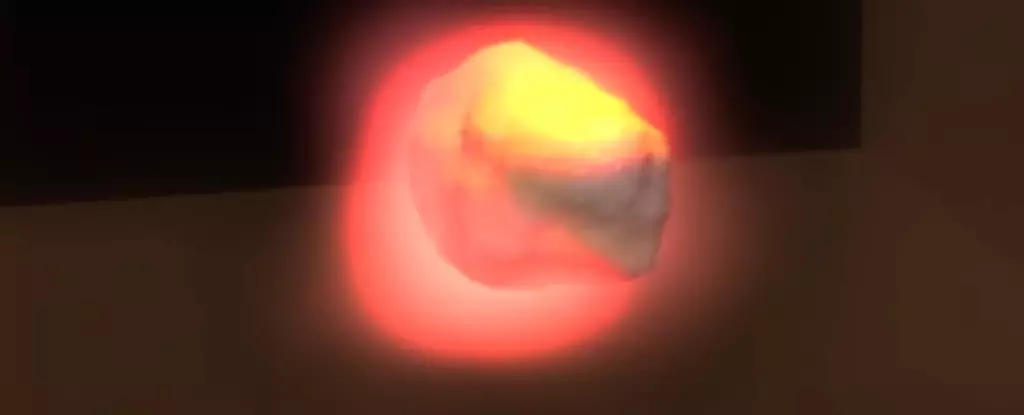NASA’s Curiosity rover has recently made a groundbreaking discovery on Mars, uncovering the largest organic molecules ever detected on the planet. This monumental finding could potentially reshape our understanding of Mars’ past and its capacity to harbor life. Organic molecules, particularly those containing carbon, play a pivotal role in the biology of life as we know it. On Earth, long-chain organic compounds are integral to cellular structures and metabolic processes. Therefore, the identification of these massive organic molecules garners immense excitement in the ongoing quest to uncover the mystery of life on the red planet.
The significance of this discovery cannot be understated. While previous findings on Mars hinted at the presence of basic organic compounds, the complexity of finding these larger, more intricate molecules suggests that the potential for microbial life may have existed long ago. This sensation ties into the longstanding intrigue surrounding Mars, a planet that has captivated scientists and enthusiasts alike, precipitating intense debates on whether life ever took root on its arid surface.
The Method of Discovery
The organic compounds were detected in a 3.7 billion-year-old rock formation known as “Cumberland,” discovered in Gale Crater’s Yellowknife Bay. This site is of particular interest due to its geological features, which resemble ancient lakebeds on Earth – locations where life flourishes under the right conditions. Scientific instruments aboard Curiosity, notably the Sample Analysis at Mars (Sam), played an instrumental role in this detection, showcasing how advanced technology can push the boundaries of astrobiological research.
Curiosity’s mission extends beyond merely cataloging Martian rocks; it aims to decipher the ancient conditions that could have fostered life. The rocky substrate sampled by Curiosity hints at an equivalent of Earth’s primordial soup, where simple organic molecules could have diversified into a variety of structures, possibly culminating in life. The presence of complex hydrocarbons such as decane and dodecane—compounds associated with biological activity—excites researchers. Their discovery raises the tantalizing question: Could these organic remnants trace the footprints of ancient Martian life?
Subtle Nuances of Organic Chemistry
While the identification of these long-chain hydrocarbons is thrilling, the understanding of how they formed remains enigmatic. The process could emanate from biological activity, but there is a chance these molecules could also arise from abiotic sources—chemical reactions devoid of life. This duality emphasizes the pressing need for further examination of these compounds using more sophisticated terrestrial laboratories, which can dissect the molecular structure in ways current Martian instruments cannot.
The organic molecules uncovered by Curiosity will lead scientists to develop hypotheses about the organic chemistry that could support life, potentially drawing parallels with early life on Earth. Fatty acids, which are components of cell membranes, could introduce pathways for studying how life might originate in environments previously deemed inhospitable. This newfound knowledge may alter the fundamental definitions of where and how life can exist in the universe.
The Future of Mars Exploration
NASA’s Mars Sample Return mission, a collaboration with the European Space Agency, offers promise for future research. This ambitious initiative aims to bring Martian rock samples back to Earth, allowing for rigorous analysis using instruments and technologies unavailable on Mars. Such an endeavor could provide compelling evidence for life’s existence in Mars’ past, reigniting interest and investment in planetary exploration.
However, the financial implications of the project have raised concerns. An independent review board recently criticized the increasing budget for the Mars Sample Return mission, prompting the agencies involved to reassess their options. This scrutiny underscores the complexities of space exploration funding, where ambitions to unveil the mysteries of alien worlds may clash with budgetary constraints and administrative decision-making.
A Glimmer of Hope in Astrobiology
Despite uncertainties about the origins of the organic carbon compounds, the intact nature of these molecules after millions of years of exposure to harsh Martian conditions instills hope among astrobiologists. The presence of these long-chain molecules—evidence of Martian chemistry—could be markers of past habitability. As scientists pursue further investigations and technological advancements, the ability to answer the age-old question of whether life existed on Mars inches closer.
Curiosity’s recent findings breathe new life into the theory that Mars may have once been a refuge for microbial organisms. Each discovery pulses with the possibility that, deep within the Martian soil, clues about our cosmic neighbors await discovery, ready to transform humanity’s understanding of life in the universe. The quest continues, and as we look to the stars, Mars, with its newfound secrets, stands at the forefront of humanity’s search for extraterrestrial life.


Leave a Reply